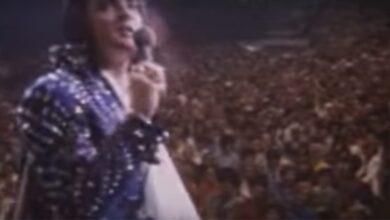In The 1950s, This Dance Was Well Known, Do You Remember It Today
In February 1958, American high school gyms and sock hops were electrified by a new dance craze known as “The Stroll.” This line dance captured the youthful exuberance of the era, reflecting the vibrant energy of the burgeoning rock ‘n’ roll culture. “The Stroll” emerged from African American communities and quickly gained widespread popularity, thanks in part to its exposure on Dick Clark’s “American Bandstand,” a television show that showcased the latest trends and dances. Teenagers across the country eagerly embraced the dance, incorporating it into their social gatherings and local dance events.
The structure of “The Stroll” was both simple and engaging. Participants formed two lines facing each other, creating an aisle down the middle. Couples would then take turns walking down the aisle in time with the music, adding their own personal style to the movements. This format allowed for a blend of group participation and individual expression, making the dance an ideal way for teenagers to socialize and showcase their personalities. The ease with which “The Stroll” could be learned and performed contributed to its widespread appeal.
The song that became synonymous with “The Stroll” was also titled “The Stroll,” performed by the Canadian vocal group The Diamonds. Known for their smooth harmonies and catchy melodies, The Diamonds played a crucial role in popularizing the dance. Their rendition of “The Stroll” served as the perfect accompaniment, capturing the upbeat, playful spirit of the dance craze. Dave Somerville, the group’s lead singer, delivered the song with a rich baritone voice that became emblematic of the dance’s lively atmosphere.
“The Stroll” quickly became a staple at dance parties and social events, captivating teenagers across the nation. Its appeal transcended racial and social boundaries, resonating with a diverse audience at a time when the United States was grappling with issues of segregation and civil rights. The dance’s accessibility and universal charm made it a favorite among high school students, who embraced it as a way to express their identity and join the latest cultural trend.
The dance craze of “The Stroll” was more than just a fleeting trend; it was a reflection of the optimistic spirit of post-war America. Teenagers, dressed in their finest outfits, would proudly take their turn strolling down the aisle, embodying the carefree and rebellious attitude of the era. The widespread adoption of “The Stroll” highlighted the power of popular culture to bring people together and create shared experiences across different communities.
As the years went by, “The Stroll” continued to be a symbol of 1950s youth culture. It remains a nostalgic reminder of a time when rock ‘n’ roll and dancing were at the forefront of American social life. The dance’s enduring legacy is a testament to its ability to capture the imagination of a generation and become a cherished part of musical and cultural history.
?si=CbHsPwTM-VodZAIG





